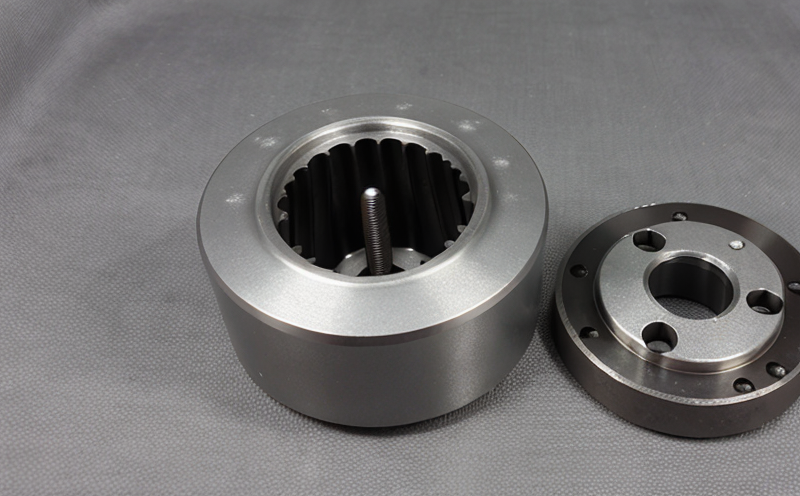ISO 13320 Particle Size Distribution by Laser Diffraction
The ISO 13320 standard is a cornerstone in the field of powder metallurgy and additive manufacturing, providing a robust method for determining particle size distribution through laser diffraction. This technique is widely used to assess particles ranging from nanometers to millimeters, offering unparalleled precision and versatility.
This service is crucial for quality managers, compliance officers, R&D engineers, and procurement teams who need reliable data on the physical characteristics of powders. Particle size distribution significantly influences processability, mechanical properties, and performance in various applications across industries such as automotive, aerospace, electronics, and medical devices.
The laser diffraction method measures the scattering pattern of light from a collimated beam when it encounters particles suspended in a carrier liquid. This interaction generates information about particle sizes based on the angle at which the scattered light is detected. The precision and accuracy of this method make it indispensable for ensuring product quality, process optimization, and regulatory compliance.
The testing procedure involves several critical steps: preparation of the sample, calibration of equipment, measurement setup, data acquisition, and analysis. Proper specimen preparation ensures accurate results, which can be achieved by dispersing particles in a suitable liquid carrier to achieve a stable suspension. Calibration is essential for ensuring that the instrument responds accurately to known particle sizes.
The key instruments used include laser diffraction analyzers equipped with advanced optical systems designed to capture detailed scattering patterns from the dispersed particles. Data acquisition and analysis are typically performed using software provided by the manufacturer, which processes raw data into meaningful distributions of particle size.
Accurate reporting is vital for compliance and quality assurance purposes. Reports generated from this service detail the measured particle sizes along with statistical parameters such as mean diameter, volume median, and weight median diameters. These metrics provide a comprehensive overview of the powder's characteristics, aiding in process optimization and product development.
| Applied Standards | Description |
|---|---|
| ISO 13320:2015 Particle Size Distribution — Laser Diffraction Method | This standard specifies the laser diffraction method for determining particle size distributions of powders and other particulate materials. It provides a detailed protocol for preparation, calibration, measurement setup, data acquisition, and analysis. |
| ASTM E1592-06 Standard Practice for Particle Size Distribution (PSD) by Laser Diffraction | This practice outlines the use of laser diffraction techniques to determine particle size distributions. It complements ISO 13320 and provides additional guidance on specific applications. |
| EN 14886-2:2005 Particle Size Distribution — Laser Diffraction Method | This European standard is aligned with ISO 13320, offering a harmonized approach to particle size distribution measurement using laser diffraction. |
Understanding the application of these standards ensures that testing results are consistent and comparable across different laboratories. This consistency is essential for maintaining quality control and ensuring compliance with industry regulations.
Applied Standards
- ISO 13320:2015 Particle Size Distribution — Laser Diffraction Method
- ASTM E1592-06 Standard Practice for Particle Size Distribution (PSD) by Laser Diffraction
- EN 14886-2:2005 Particle Size Distribution — Laser Diffraction Method
The ISO 13320 standard is widely recognized and used globally, ensuring that the results of particle size distribution testing are consistent with international best practices. Compliance with these standards not only enhances product quality but also facilitates easier regulatory compliance.
Scope and Methodology
The scope of this service encompasses the determination of particle size distribution for powders using laser diffraction. The methodology involves several key steps:
- Sample Preparation: Ensuring that particles are evenly dispersed in a suitable liquid carrier.
- Calibration: Adjusting the instrument to accurately measure known reference samples.
- Measurement Setup: Configuring the laser diffraction analyzer for optimal performance.
- Data Acquisition: Capturing detailed scattering patterns from the dispersed particles.
- Data Analysis: Processing raw data into meaningful distributions of particle size using specialized software.
The precision and accuracy of these steps are critical to obtaining reliable results. Proper calibration ensures that measurements are consistent, while accurate data acquisition provides a clear picture of the scattering patterns. Data analysis then translates this information into useful metrics such as mean diameter, volume median, and weight median diameters.
These metrics provide valuable insights into the physical characteristics of powders, which are crucial for optimizing processes and ensuring product quality. The ability to measure particle size distribution accurately is particularly important in industries where precise control over material properties is essential.
Competitive Advantage and Market Impact
- Innovation: Early detection of potential issues during the R&D phase, enabling timely adjustments to improve product performance.
- Efficiency: Streamlined quality control processes resulting in reduced downtime and increased productivity.
- Regulatory Compliance: Ensuring adherence to industry standards and regulations, which is critical for maintaining market access.
- Customer Satisfaction: Providing consistent product quality that meets or exceeds customer expectations.
The ability to accurately measure particle size distribution using ISO 13320 laser diffraction offers significant competitive advantages in the metallurgy and material testing sector. By ensuring high-quality products, this service supports innovation and efficiency, while also facilitating regulatory compliance and enhancing customer satisfaction.





